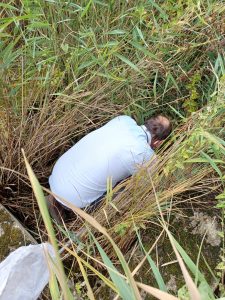…blog by Jo Loman, Buglife Canvey Wick Community Warden
It seems there is a national or global day for almost anything now from health and wellbeing, food and drink to smiles and even boyfriends! In early October there are two official global days where we come together to celebrate World Habitats Day (3rd) and World Animal Day (4th). This is the feast day of St. Francis of Assisi, the patron saint of animals and ecology, as legend claims that Saint Francis was able to talk to the animals.

Ecology is defined as the study of organisms and how they interact with the environment around them. So, an ecologist studies the relationship between living things and their habitats, which ties these two days together beautifully.
At Buglife, as part of our No Insectinction campaign, we promote having room for insects to thrive where we need to make space for wildlife and reconnect the wild parts of our landscapes. This is exactly what we are doing at our Canvey Wick Bug Nature Reserve in Essex. A reserve that is a Site of Special Scientific Interest (SSSI) requires a management plan that covers the variety of habitats and species found at this former industrial site. There are herb-rich grasslands, lichen heath, dry reed beds and exposed tarmac areas where it is essential to know which invertebrates are living in each habitat and how these spaces are utilised in their complex lifecycles.
It is therefore, necessary to conduct invertebrate surveys to establish the populations that are found on the site. Over the course of this season, from May to September, local ecologists Peter Harvey and Adrian Knowles have visited Canvey Wick each month for repeat surveys. I joined them for their final visit in September to see the survey methods used and to hear some of the fascinating stories associated with the invertebrates that were found.

Firstly, Peter & Adrian check the roofing mats that were placed to attract invertebrates that seek warmth and areas for basking. They also sampled the man-made beetle habitat. This comprises a range of stones and rocky material that mimics cleared industrial sites with nooks and crannies in the sparsely vegetated piles. This creates diversity in the habitats available and also provides a range of different microclimates.
Adrian then uses a specially designed Bugvac that gently sucks up all the invertebrates that are hiding on and under the vegetation at an area of concrete base foundation. He then empties the filter onto a white sheet to see what creatures he has sampled. In the grasslands and shrub by the dry reed beds, Peter used a sweep net and his technique of getting inside the net, to collect the flying insects before they can escape. A pooter; a small tube system connected to a vial that sucks up the captured invertebrate, is used to retain samples that require closer inspection to identify accurately. Both Peter and Adrian have decades of experience in the field and identify some species straight away based on their knowledge and association to the habitat being surveyed, but others are sent to species specialists.
To date, more than 1,500 species of invertebrate have been recorded at Canvey Wick including rare beetles, bees, wasps, moths and dragonflies. This crucial survey work informs the management plan so that Buglife and RSPB, who manage the reserve, can undertake habitat restoration to benefit the resident invertebrates.
So this month, will see works start at Canvey Wick to restore open mosaic habitats and remove some of the encroaching scrub to create favourable environments for the rare invertebrates cited in the SSSI designation. This feels like a wholly appropriate way to celebrate both World Habitats and World Animal Day.
If you’d like to take action for invertebrates to celebrate too then see the links to gardening for bugs and pollinator guidance.



